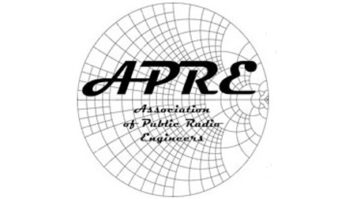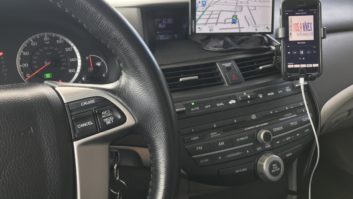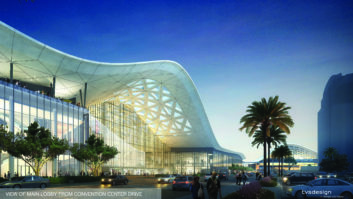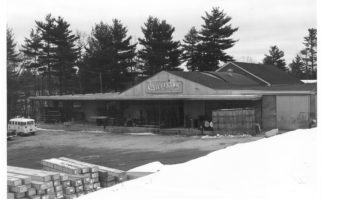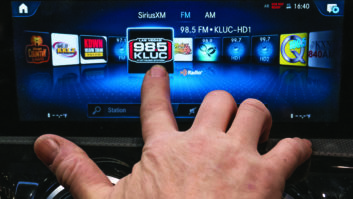From Howard Hughes to ‘The Drive,’ Highway Radio Keeps the High Desert Tuned In
If you’ve ever driven from southern California to Las Vegas, you’ve probably noticed something about the radio dial once you cross over the mountains and into the desert.
There’s not much there.
But as empty as the dial may sound in 2005, it was even quieter three decades ago, when a young marketing executive for the legendary Howard Hughes came up with the idea for what would eventually become Highway Radio.
Captive audience
“There was no FM service anywhere on the highway,” recalled Howard Anderson. “It was a white area.”
Hughes is best known today for his money, eccentricities, womanizing and adventures in the air. But the mogul had broadcast interests, too, having owned Las Vegas’ KLAS(TV). And he owned several casinos, including the Desert Inn.
Back then, Anderson was the casinos’ vice president for marketing, with a keen interest in broadcasting stoked by a career that began at Salt Lake City experimental TV station W6XIS and included time at Dallas’ WFAA(TV), ABC and Twentieth Century Fox TV before joining Hughes’ organization.
“We knew there was a microwave relay station that KLAS had used on Calico Peak, outside of Barstow,” Anderson said, noting that a signal from that site would reach most of the I-15 freeway between the California/Nevada border and the fringes of the Los Angeles area.
Anderson also knew that nearly half of all Las Vegas casino customers at the time came from southern California – and that the cost of advertising on Los Angeles radio stations was prohibitive.
“We knew if we could get (casino patrons) when they were already destined to Las Vegas, we’d have a very effective advertising medium,” Anderson said. With their inside knowledge of the casino world, the station’s planners determined that if they could get just 5 percent of the Las Vegas casinos’ advertising budget, “we could crack our nut.”
Life after Hughes
Not long after Anderson had drafted a business plan for a chain of radio signals serving the I-15 corridor, Hughes died. For the next two years, Anderson’s attention was focused on getting Hughes’ Summa Corp. stabilized and sold off. But after reopening the Desert Inn in October 1978, Anderson returned to the radio plan that he’d concocted for Hughes.
This time, he was ready to try getting it on the air himself.
In addition to the signal from Calico Peak – for which Anderson applied using the tiny community of Yermo, Calif., as city of license to avoid tipping off AM stations in nearby Barstow to the impending competition – Anderson wanted a second signal to serve drivers on the eastern portion of I-15, from Baker to the Nevada border and down into Las Vegas.
Finding a transmitter site in the mountainous area wasn’t hard, but finding a city of license in the sparsely populated desert was another matter. The likeliest candidate was the town of Mountain Pass, Calif., population barely in double digits. Yet it had a post office and a grade school, since closed – and it had Anderson selling his case to Wally Johnson, then head of the FCC’s Mass Media Bureau.
“We persuaded him that people on the highway, because they had common interests, needs and problems, constituted a community themselves,” Anderson said, and by the end of 1979, he was the proud holder of two high-power FM construction permits serving a whole lot of desert.
“Yermo and Mountain Pass,” Anderson recalled, “what kind of a fruitcake thinks he’s going to make any money off those?”
Serving the highway
“The Highway Stations,” KRXV(FM) 98.1 Yermo and KXVR(FM) 99.5 Mountain Pass – the “XV” in the calls came from I-15 – signed on in 1980, initially offering a format meant to appeal to fans of Vegas-style entertainment.
“It was mostly featuring the artists who were appearing in Las Vegas at the time,” Anderson said, “Tony Bennett and Frank Sinatra.”
From that humble start, the service grew, first with a power boost for the Mountain Pass transmitter, which required a waiver to exceed Class B maximum facilities; this the FCC granted on the grounds that it would better serve the station’s mobile “community” of listeners. Later came the 1991 debut of a third transmitter on Goffs Butte, 30 miles west of Needles, Calif. That signal served the I-40 corridor, of increasing importance with the rise of Laughlin, Nev., as a gaming destination.
Covering the highway with signal was one thing, though. For the Highway Stations to succeed, they had to get advertising. With most of its audience in cars, and almost none of them living in the station’s “home market,” that was quite a challenge.
“Arbitron hasn’t a clue as to how to measure in-car listening,” Anderson said.
So after blanketing the highways with promotions for the stations, the Highway Stations had to hit the road to find out who was listening.
“We do intercept research along the highway,” Anderson said, “and we find that we deliver about a 35 rating and an 80 share.”
But the proof is in the results. After boosting the power of the Mountain Pass transmitter, Anderson approached the owner of the casino at Primm, Nev. – the first casino drivers pass as they cross the Nevada state line – to advertise.
The client “was skeptical at first … but he came on board,” Anderson recalled, and within three years, business at Primm had increased 300 percent.
Within that time, the Highway Stations also had achieved their initial goal of taking in 5 percent of the Vegas casinos’ ad budget. As a privately held company, Highway Radio doesn’t release its financial figures, but Anderson says the stations are solidly profitable and thoroughly unique.
“We do not see any other location where this would work,” Anderson said.
Anderson says there’s plenty of evidence that the ever-growing traffic along I-15 is paying attention to his signals. If an announcer makes a mistake when promoting a room rate, Anderson says, the station’s phone is ringing “within 45 minutes,” as drivers show up at the casinos asking for the incorrect rate.
Unlike traditional radio, there’s no drive time at the Highway Stations, either. Casino advertisers aren’t very interested in anything before 10 in the morning, Anderson says. So his stations do a morning show that’s aimed at local listeners (and advertisers) in Barstow, the commercial hub of the High Desert, and later in the day they depend on cume to get their advertisers’ message out to an audience that’s constantly coming and going along the highway.
“If any advertiser comes to me and says, ‘Give me seven spots a week,’ we say ‘No, that’s foolish, ‘” Anderson said.
On the air
The Highway Stations’ on-air presentation has changed since the days of Sinatra and Bennett. Today, listeners to the three signals hear adult contemporary music, but with some features few other stations offer. Most important, says Anderson, is the 24-hour traffic-report service, with constant repetition of the stations’ toll-free hotline to report traffic problems.
The stations feed Metro Traffic, Anderson said. “Many times we know about accidents and problems before the Highway Patrol does.”
In addition to the main Highway Stations service, Anderson’s interstate empire, now known simply as Highway Radio, today includes two more formats.
Five years ago, Anderson bought out a new competitor, three lower-powered signals called “Highway Country.” Three years ago, Anderson won two more FM licenses and put them on the air as “Highway Rock, the Drive,” appealing to a younger audience.
While the newer services are mostly automated, the presence of a live DJ 24 hours a day on the Highway Stations means listeners to all three formats get immediate updates whenever there’s an accident or a weather problem on the highway. Anderson says that, in turn, gives the stations something that CDs or satellite radio can’t offer drivers.
“We take very seriously the principle of localism,” he said.
Promoting the stations is a challenge, as well. Anderson says he’s had particular success with the “Adopt A Highway” program. More than 150 miles of I-15 and I-40 are now dotted with “Adopt A Highway” signs promoting the three services. The stations also have two vans that travel the highways, making frequent appearances at casinos and at rest stops along the road.
To serve its advertisers, Highway Radio maintains a sales office in Las Vegas, where its sales staff holds frequent breakfasts to keep the casinos updated on traffic counts, construction and other issues of special importance to their mobile “community” of listeners. (The stations also distribute a monthly newsletter on their Web site to spread that information.)
And if you get off the highway to stretch your legs at the Barstow Station restaurant/gift shop/bus terminal that beckons weary drivers off I-15 near the junction with I-40, be sure to look up from the racks of T-shirts and snow globes and other trinkets. The Highway Stations’ offices and studios are right up there on the second floor, overlooking both the tourists downstairs and the audience that’s constantly coming and going on the highways below.





